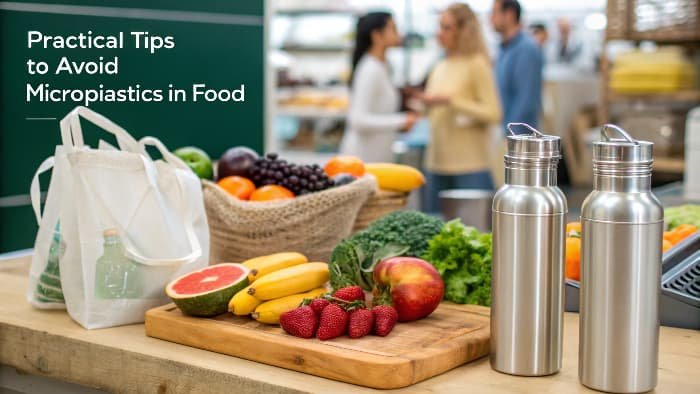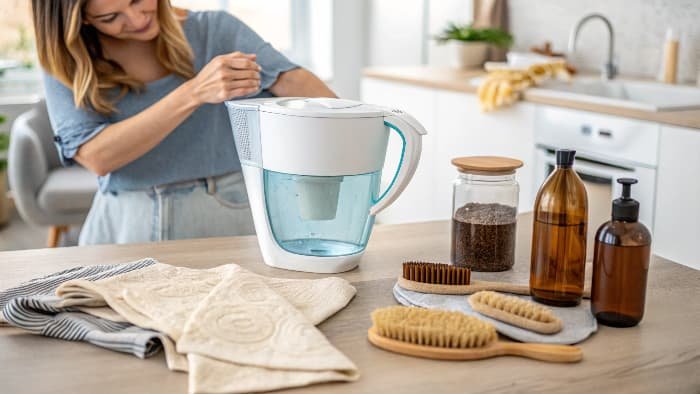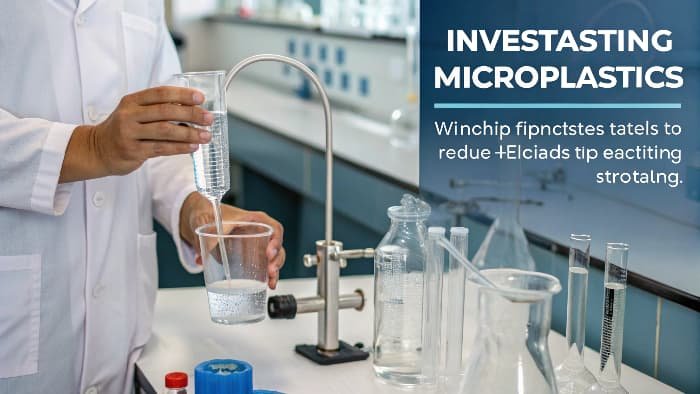Worried about tiny plastics in your meals? It’s a hidden concern impacting our health. Learn how to minimize your exposure and protect yourself.
Microplastics in food pose potential health risks still under investigation. To reduce exposure, limit processed foods and bottled water, avoid microwaving in plastic, and opt for glass or stainless steel for food storage and cooking.
The thought of eating plastic, even tiny bits, is pretty unsettling, right? It’s something I’ve been looking into more and more, especially with all the headlines. We hear about microplastics everywhere – in the ocean, in the air, and scarily, in our food. For people like Jacky, who’s super focused on eco-friendly packaging and health for his Canadian brand, this is a big deal. It makes you wonder what’s really going on and what we can actually do about it. So, let’s dig into this a bit, figure out the real scoop, and see how we can keep these pesky plastics off our plates. It’s a bit like being a detective in your own kitchen!
Are microplastics in food a threat to your health?
Unsure if those invisible plastics in your food are truly harmful? The science is still emerging. Let’s look at what we know about the risks.
While direct, long-term health effects of ingesting microplastics are still being researched, studies suggest potential issues like inflammation, oxidative stress, and impacts on gut health. The "precautionary principle" suggests minimizing exposure where possible.
!
So, what are these microplastics anyway? Well, they’re tiny plastic particles, generally less than 5 millimeters in size – some are so small they’re invisible to the naked eye, called nanoplastics. They come from two main places: primary sources, like microbeads in cosmetics (though thankfully many are banned now!) or industrial abrasives, and secondary sources, which are bits that break off larger plastic items like packaging, synthetic clothing fibers, or car tires. It’s these secondary ones that are a huge worry for food. They can get into our food chain through contaminated water, soil, or even from the packaging itself. I remember reading a study about how plastic cutting boards can shed loads of particles directly onto your food – yikes!
The big question, of course, is what they do to us. The honest answer is scientists are still figuring it all out. It’s a really complex area. Some potential concerns include physical irritation in our gut, though that’s more theoretical for now. The more likely issue comes from the chemicals in or on the plastics. Plastics often contain additives like BPA or phthalates to give them certain properties (flexibility, color), and these can leach out. Plus, microplastics floating in the environment can act like little sponges, soaking up other pollutants. So, when we ingest them, we might be getting a dose of those chemicals too. There’s talk about potential inflammation, impacts on our immune system, and even disruptions to our gut microbiome – that delicate balance of bacteria in our digestive system. The really tiny nanoplastics are a particular worry because they might be able to pass through our intestinal walls and travel to other organs. As someone running Ecosourcecn, promoting safer alternatives is key, because consumer trust is everything. If people are worried about plastics in their food containers, it affects everyone. It’s definitely a case where "more research is needed" is the tagline, but in the meantime, being a bit cautious seems like a good idea.
How to avoid microplastics in food?
Want to reduce plastics on your plate but don’t know where to start? Simple food choices can make a big difference. Discover practical tips now.
Avoid microplastics in food by choosing fresh, whole foods over heavily processed ones. Reduce reliance on plastic packaging and bottled water. Opt for glass or stainless steel containers for storage and cooking.

This is where we can actually take some control, which feels good! It’s about making smarter choices day-to-day. One of the biggest things I’ve found is to lean towards fresh, whole foods. Think about it – an apple doesn’t come in plastic, but a ready-meal often does, along with multiple layers of it. The more processed a food is, the more chances it’s had to come into contact with plastic packaging or equipment.
Bottled water is another biggie. Studies have found surprisingly high levels of microplastics in bottled water. I made the switch to a good quality reusable stainless steel bottle years ago and just refill it from the tap – I use a filter at home for good measure. It was a small change, but I reckon it’s cut down my plastic particle intake significantly.
When it comes to food packaging and storage, try to steer clear of plastic where you can. If you’re buying something like pasta sauce or pickles, go for the glass jar option. Store leftovers in glass or stainless steel containers instead of plastic ones. And please, please, please don’t microwave food in plastic containers! Even if they say "microwave-safe," heating can encourage chemicals and particles to leach into your food. I always transfer food to a ceramic plate or glass dish before nuking it. Cling film, especially with fatty foods like cheese, can also be a source of transfer. I try to use beeswax wraps or just put the cheese in a container.
Seafood, particularly shellfish like mussels and oysters that filter a lot of water, can accumulate microplastics. This doesn’t mean you have to give it up entirely, but maybe vary your seafood choices and try to find out about the source if possible. And tea bags! I was shocked when I learned many tea bags actually contain plastic (polypropylene) to help them seal and keep their shape in hot water. Switching to loose-leaf tea and a metal infuser was an easy fix for me. Even your cutting board matters. Those old plastic ones? They can shed particles right into your salad. I switched to a big wooden one, and it feels much better. At Ecosourcecn, when we offer items like bagasse takeaway containers, part of the thinking is to provide options that minimize this kind of direct plastic-to-food contact, especially for hot foods.
How to stop microplastics from entering your body?
Microplastics aren’t just in food; they’re airborne and in everyday items. Feeling exposed? Learn holistic ways to reduce your overall intake from all sources.
Stop microplastics by filtering drinking water and air, choosing natural fiber clothing, using non-plastic personal care products, and reducing overall plastic use in your home. Regular dusting and vacuuming also help.

It’s a bit like fighting an invisible enemy, but there are definitely broader steps we can take beyond just what’s on our dinner plate. Since we know tap water can sometimes contain microplastics (though generally less than bottled water), using a good water filter is a smart move. There are various types, from simple carbon filters in pitchers to more advanced systems like reverse osmosis. I use a pitcher filter for my drinking water, and it gives me peace of mind.
Then there’s the air we breathe. Sounds crazy, but microplastics are in household dust! A lot of this comes from synthetic textiles – things like polyester or nylon clothes, carpets, and upholstery. When you wear them, wash them, or even just walk on them, tiny fibers break off. So, choosing natural fibers like cotton, wool, linen, or hemp for clothing and home furnishings can help. I’ve been gradually trying to buy more cotton T-shirts and wool sweaters. Regularly vacuuming with a machine that has a HEPA filter and dusting with a damp cloth can also trap these airborne particles before you inhale them. Some people even use air purifiers.
Personal care products can be another sneaky source. Remember microbeads in face scrubs? Most are banned now, but plastics can still be found in other cosmetics, often as glitter or thickeners. Always check the ingredients! And think about the packaging – so much plastic! I’ve been exploring shampoo bars and products in glass or metal.
For parents, baby bottles and toys are a big concern. Babies chew on everything! Opting for glass baby bottles and toys made from wood or natural rubber can reduce their exposure, especially since heating plastic bottles can release more particles. I noticed a big difference when I switched my old plastic kettle for a stainless steel one – not just for potential microplastics, but it just feels cleaner and safer. It’s all part of a bigger shift towards a less plastic-dependent lifestyle, which is really what we champion at Ecosourcecn – thinking about the whole system, not just one product.
How do you remove 90% of microplastics?
Heard claims about removing vast amounts of microplastics? It sounds amazing, but is it really possible? Let’s investigate the facts behind such statements.
No single method removes 90% of all microplastic exposure. However, specific interventions like boiling and filtering tap water, or using certain water filtration systems, can significantly reduce microplastics in drinking water.
 Ah, the magic "90% removal" claim! It pops up now and then, and it sounds fantastic, doesn’t it? Like a silver bullet. But, as with most things that sound too good to be true, it needs a closer look. There isn’t one simple trick that will remove 90% of all microplastics you might encounter from every source – food, water, air. That’s just not realistic right now. However, that 90% figure often comes from specific scientific studies, usually related to drinking water. For example, a study published in early 2024 found that boiling hard tap water for about five minutes and then filtering it (like through a coffee filter or fine sieve) could remove around 90% of nano- and microplastics (NMPs). What happens is that when you boil hard water (water with lots of minerals like calcium), calcium carbonate (like limescale) forms. These tiny mineral crystals can apparently trap the NMP particles. Then, when you filter the water, you remove these mineral-NMP clumps. Pretty neat, huh? But, there are caveats: it works best with hard water. If your tap water is soft, it’s less effective. And, of course, this method is only for water you’re about to drink or cook with, not for plastics already in your food or in the air. Other methods can also achieve high reduction rates for specific sources. Advanced water filtration systems, like those using reverse osmosis, are very effective at removing a wide range of contaminants from water, including microplastics. Similarly, HEPA air filters are designed to capture very small airborne particles, which would include airborne microplastics from textiles or dust. So, while you can’t magically eliminate 90% of all exposure, you can significantly reduce your intake from key sources like drinking water by using these targeted methods. It’s more about a combined strategy of reducing input (like choosing less plastic packaging, which is where Ecosourcecn comes in by offering alternatives) and using filtration where appropriate. The key is focusing on prevention first, because once those tiny plastics are in your food or, even worse, in your body, getting them out is a whole different, and much harder, challenge. |
Method | Claimed Reduction (Context) | How it Works | Limitations |
|---|---|---|---|---|
| Boiling & Filtering Tap Water (Hard) | Up to 90% (Nano/Microplastics in water) | Calcium carbonate precipitation traps plastics | Best with hard water, filtration step needed, only for water | |
| Reverse Osmosis Water Filter | Very High (Microplastics & contaminants in water) | Semi-permeable membrane blocks particles | Cost, water waste, may remove beneficial minerals, for water only | |
| HEPA Air Filter | High (Airborne particles incl. microplastics) | Fine mesh traps small particles | Only for air, filter replacement, unit cost | |
| Avoiding Plastic Food Packaging | Significant (Reduction from direct food source) | Reduces leaching/transfer from packaging to food | Not always possible, depends on food type/availability |
Conclusion
Microplastics are a concern, but informed choices can reduce exposure. Focus on fresh foods, better packaging, and smart habits to minimize risks and protect your health.


